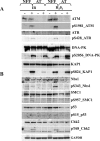Reactive Oxygen Species (ROS)-Activated ATM-Dependent Phosphorylation of Cytoplasmic Substrates Identified by Large-Scale Phosphoproteomics Screen
- PMID: 26699800
- PMCID: PMC4813686
- DOI: 10.1074/mcp.M115.055723
Reactive Oxygen Species (ROS)-Activated ATM-Dependent Phosphorylation of Cytoplasmic Substrates Identified by Large-Scale Phosphoproteomics Screen
Abstract
Ataxia-telangiectasia, mutated (ATM) protein plays a central role in phosphorylating a network of proteins in response to DNA damage. These proteins function in signaling pathways designed to maintain the stability of the genome and minimize the risk of disease by controlling cell cycle checkpoints, initiating DNA repair, and regulating gene expression. ATM kinase can be activated by a variety of stimuli, including oxidative stress. Here, we confirmed activation of cytoplasmic ATM by autophosphorylation at multiple sites. Then we employed a global quantitative phosphoproteomics approach to identify cytoplasmic proteins altered in their phosphorylation state in control and ataxia-telangiectasia (A-T) cells in response to oxidative damage. We demonstrated that ATM was activated by oxidative damage in the cytoplasm as well as in the nucleus and identified a total of 9,833 phosphorylation sites, including 6,686 high-confidence sites mapping to 2,536 unique proteins. A total of 62 differentially phosphorylated peptides were identified; of these, 43 were phosphorylated in control but not in A-T cells, and 19 varied in their level of phosphorylation. Motif enrichment analysis of phosphopeptides revealed that consensus ATM serine glutamine sites were overrepresented. When considering phosphorylation events, only observed in control cells (not observed in A-T cells), with predicted ATM sites phosphoSerine/phosphoThreonine glutamine, we narrowed this list to 11 candidate ATM-dependent cytoplasmic proteins. Two of these 11 were previously described as ATM substrates (HMGA1 and UIMCI/RAP80), another five were identified in a whole cell extract phosphoproteomic screens, and the remaining four proteins had not been identified previously in DNA damage response screens. We validated the phosphorylation of three of these proteins (oxidative stress responsive 1 (OSR1), HDGF, and ccdc82) as ATM dependent after H2O2 exposure, and another protein (S100A11) demonstrated ATM-dependence for translocation from the cytoplasm to the nucleus. These data provide new insights into the activation of ATM by oxidative stress through identification of novel substrates for ATM in the cytoplasm.
© 2016 by The American Society for Biochemistry and Molecular Biology, Inc.
Figures







References
-
- Lavin M. F. (2008) Ataxia-telangiectasia: From a rare disorder to a paradigm for cell signalling and cancer. Nat. Rev. Mol. Cell Biol. 9, 759–769 - PubMed
-
- Shiloh Y. (2014) ATM: Expanding roles as a chief guardian of genome stability. Exp. Cell Res. 329, 154–161 - PubMed
-
- Shiloh Y., and Ziv Y. (2013) The ATM protein kinase: Regulating the cellular response to genotoxic stress, and more. Nat. Rev. Mol. Cell Biol. 14, 197–210 - PubMed
-
- Paull T. T. (2015) Mechanisms of ATM activation. Annu. Rev. Biochem. 84, 711–738 - PubMed
Publication types
MeSH terms
Substances
LinkOut - more resources
Full Text Sources
Medical
Research Materials
Miscellaneous

